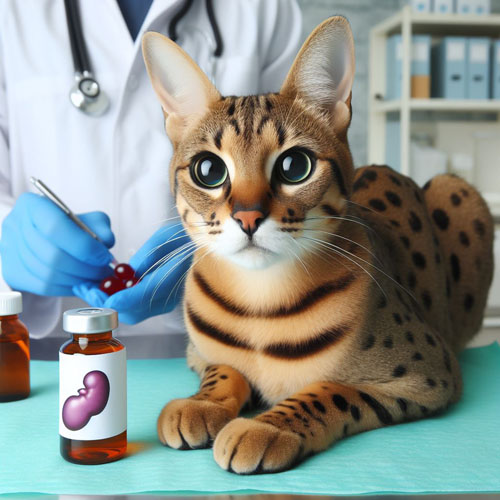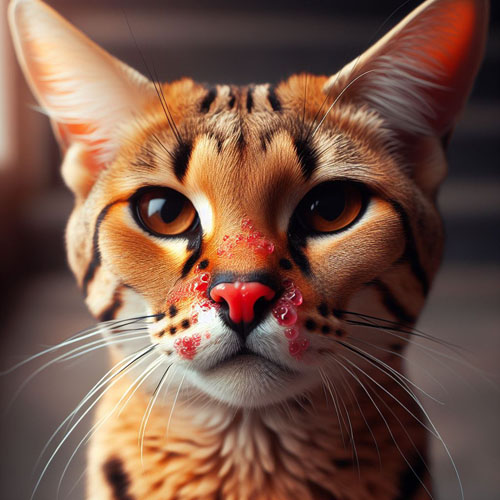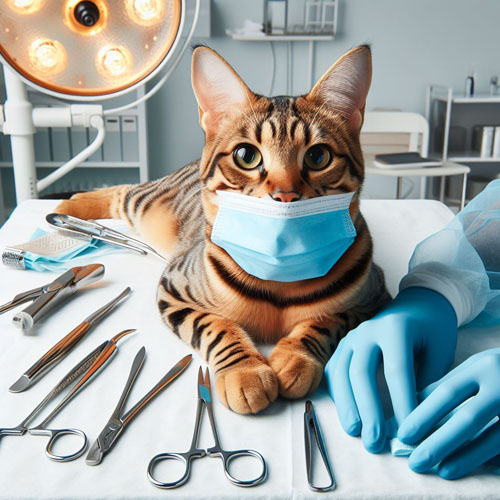Understanding Cataracts in Elderly Savannah Cats
Understanding Cataracts in Elderly Savannah Cats: Causes, Symptoms, and Care
Savannah cats can face various health challenges as they age, much like any other feline companion. Cataracts represent a common ocular concern, not only in humans but also in our feline companions. In this comprehensive exploration, we delve into the intricacies of cataracts, uncovering their causes, recognizing symptoms in elderly Savannah cats, and exploring various care options.
What are Cataracts: Cataracts are a condition that affects the eye’s clarity and vision. They are a common eye condition in cats, characterized by the clouding of the eye’s lens. The lens is a transparent structure behind the pupil that helps focus light onto the retina, allowing the cat to see clearly. In elderly Savannah cats, the lens can become progressively opaque, hindering light passage and causing vision impairment.
Causes of Cataracts in Savannah Cats: Several factors contribute to the development of cataracts in elderly Savannah cats:
- Age: Advanced age is a primary risk factor for cataract development. As Savannah cats age, their cells may undergo changes, leading to the breakdown of proteins within the lens.
- Genetics: Genetic predisposition can play a role in cataract formation. If a Savannah cat has a family history of cataracts, they may be more susceptible to the condition.
- Diabetes: Cats, including Savannahs, can develop diabetes, which increases the risk of cataracts. Diabetic cats may experience fluctuations in blood sugar levels, contributing to lens opacity.
- Trauma: Physical injuries or trauma to the eye can cause cataracts to develop. Savannah cats with a history of eye injuries are at an elevated risk.
Recognizing Cataract Symptoms: Identifying cataracts in elderly Savannah cats is crucial for prompt intervention. Watch out for the following symptoms:
- Cloudy or Hazy Eyes: The most apparent sign of cataracts is the cloudiness or haziness in the affected eye(s). This cloudiness can range from mild to severe.
- Changes in Pupil Color: The cat’s pupils may undergo a noticeable change in color, appearing bluish, white, or opaque.
- Altered Behavior: Cats with cataracts might exhibit changes in behavior, such as increased clumsiness, reluctance to jump or climb, or heightened sensitivity to light.
- Reduced Night Vision: Savannah cats may experience a decline in night vision as cataracts progress, leading to reluctance to navigate in low-light conditions.
Diagnosing Cataracts in Savannah Cats: If you suspect your elderly Savannah cat has cataracts, consult a veterinarian for a thorough eye examination. The vet may perform various tests, including:
- Ophthalmic Exam: The veterinarian will examine the cat’s eyes using specialized instruments to assess the degree of cloudiness in the lenses.
- Blood Tests: If diabetes is suspected, blood tests may be conducted to measure blood sugar levels and identify potential contributing factors.
- Genetic Testing: In cases where a genetic predisposition is suspected, genetic testing may be recommended to assess the cat’s susceptibility to cataracts.
Treatment Options for Cataracts in Savannah Cats: While cataracts cannot be reversed, various treatment options can help manage the condition and improve the cat’s quality of life:
- Surgical Intervention: In severe cases, surgical removal of the cataract may be recommended. This procedure, called phacoemulsification, involves breaking down the cloudy lens and replacing it with an artificial one.
- Medications: Depending on the underlying cause of cataracts, medications may be prescribed to manage diabetes or address other contributing factors.
- Nutritional Supplements: Certain supplements, such as antioxidants, may support eye health and slow the progression of cataracts.
- Environmental Adaptations: Modifying the cat’s environment by minimizing obstacles and ensuring proper lighting can help the cat navigate more comfortably.
Preventive Measures and Care for Savannah Cats: While not all cases of cataracts can be prevented, there are steps Savannah cat owners can take to promote eye health and overall well-being:
- Regular Veterinary Check-ups: Routine veterinary visits can help monitor your cat’s eye health and detect early signs of cataracts or other ocular conditions.
- Balanced Diet: Providing a nutritionally balanced diet can contribute to overall health, including eye health. Consult with your veterinarian to ensure your Savannah cat’s diet meets their specific needs.
- Diabetes Management: If your cat has diabetes, diligent management of the condition is essential. This includes regular blood sugar monitoring, insulin administration if prescribed, and dietary adjustments.
- Environmental Enrichment: Keep your Savannah cat mentally and physically stimulated to promote overall well-being. Provide interactive toys, scratching posts, and opportunities for play and exploration.
Conclusion:
Cataracts in elderly Savannah cats can pose challenges, but with timely intervention and proper care, affected cats can lead fulfilling lives. Understanding the causes, recognizing symptoms, and seeking veterinary guidance are crucial steps in managing this eye condition. By prioritizing your cat’s eye health and well-being, you can enhance their quality of life and strengthen the bond between you and your beloved Savannah companion.
Keywords: Savannah Cats, Cataracts, Elderly Felines, Cat Eye Health, Veterinary Intervention





